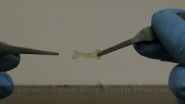Heat and acid could squeeze trout out of southern Appalachian streams
First regional assessment of the combined effects of stream temperature and acidity
2015-09-01
(Press-News.org) A newly published research study that combines effects of warming temperatures from climate change with stream acidity projects average losses of around 10 percent of stream habitat for coldwater aquatic species for seven national forests in the southern Appalachians - and up to a 20 percent loss of habitat in the Pisgah and Nantahala National Forests in western North Carolina.
Published in the online journal PLOS ONE, the results represent the first regional assessment in the U.S. of aquatic habitat suitability tied to the combined effects of stream temperature and acidity. Authors of the article include researchers from E&S Environmental Chemistry, Inc., the U.S. Forest Service, and Oregon State University.
Previous research has shown that stream-dwelling species in the southern Appalachian region are particularly vulnerable to climate change and that many coldwater species are already shifting their ranges in response to warming temperatures. Headwater streams, which provide the coldest available habitat in many areas, are often assumed to be the ultimate refuges for coldwater species, but many of these species are also acid-sensitive - and many headwaters of the southern Appalachian region are already too acid to support them.
The researchers focused on streams draining seven national forests in the southern Appalachian region, first mapping out how much of the area's current habitat is suitable for acid- and heat-sensitive aquatic species such as the native brook trout.
"We then used models to forecast future habitat loss in the national forests from expected temperature increases in the region," says Andrew Dolloff, research fishery biologist for the Forest Service Southern Research Station and a co-author of the study. "Our goal was to help watershed managers identify and assess specific stream reaches that are potentially vulnerable to stress from warming, acidification, or both."
Of the seven national forests studied, the Pisgah and Nantahala in North Carolina contained the most coldwater habitat - and are predicted to have the greatest losses in suitable habitat for acid-sensitive coldwater species. In these forests the combined effect of acidification in headwater streams and stream warming will restrict acid-sensitive coldwater species such as brook trout to a narrowing band of mid-level stream reaches, increasing the likelihood that these species will disappear locally and possibly regionally.
Though they seem discouraging, results from the study will help Forest Service managers classify watersheds in response to human-produced stressors and develop regional climate adaptation plans. Forest managers and aquatic biologists can use the study's data on specific streams for restoration planning and to assess the need for intervention (liming, riparian afforestation, native fish reintroduction) in stream reaches that are potentially vulnerable to warming, acidification, or both.
INFORMATION:
For more information, email Andrew Dolloff at adolloff@fs.fed.us.
Access the full text of the article: http://www.srs.fs.usda.gov/pubs/48955
Headquartered in Asheville, NC, the Southern Research Station comprises more than 120 scientists and several hundred support staff who conduct natural resource research in 20 locations across 13 southern states (Virginia to Texas). The Station's mission is "...to create the science and technology needed to sustain and enhance southern forest ecosystems and the benefits they provide." Learn more about the Southern Research Station at: http://www.srs.fs.usda.gov/.
ELSE PRESS RELEASES FROM THIS DATE:
2015-09-01
MRI scans and other tools to detect and diagnose dementia are helpful but not definitive - according to new research from the University of East Anglia.
A report published today in The Lancet Neurology evaluates for the first time how well different types of brain imaging tests work to detect Alzheimer's and predict how the disease will progress.
The results show that the accuracy of brain imaging must be improved before it can be rolled out on a scale that could be useful to healthcare providers and patients.
Co-author Prof Chris Fox says that overplaying the current ...
2015-09-01
Here's another discovery to bolster the case for medical marijuana: New research in mice suggests that THC, the active ingredient in marijuana, may delay the rejection of incompatible organs. Although more research is necessary to determine if there are benefits to humans, this suggests that THC, or a derivative, might prove to be a useful antirejection therapy, particularly in situations where transplanted organs may not be a perfect match. These findings were published in the September 2015 issue of The Journal of Leukocyte Biology.
"We are excited to demonstrate for ...
2015-09-01
A drop of water self-heals a multiphase polymer derived from the genetic code of squid ring teeth, which may someday extend the life of medical implants, fiber-optic cables and other hard to repair in place objects, according to an international team of researchers.
"What's unique about this plastic is the ability to stick itself back together with a drop of water," said Melik Demirel, professor of engineering science and mechanics, Penn State. "There are other materials that are self healing, but not with water."
Demirel and his team looked at the ring teeth of squid ...
2015-09-01
A new study examining changes in gun policy in two states finds that handgun purchaser licensing requirements influence suicide rates. Researchers estimate that Connecticut's 1995 law requiring individuals to obtain a permit or license to purchase a handgun after passing a background check was associated with a 15.4 percent reduction in firearm suicide rates, while Missouri's repeal of its handgun purchaser licensing law in 2007 was associated with a 16.1 percent increase in firearm suicide rates.
The study, from researchers with the Johns Hopkins Center for Gun Policy ...
2015-09-01
ITHACA, N.Y. - Restoring oyster reefs is not an easy task, but by digging deep and examining centuries-old reefs, marine restoration professionals may stand a better chance at bringing oysters back, said a new Cornell University and Paleontological Research Institution (PRI) study published in the August issue of the Journal of Shellfish Research.
Stephen R. Durham, a Cornell doctoral student in the field of earth and atmospheric sciences, with Gregory P. Dietl, curator of Cenozoic invertebrates at the Cornell-affiliated PRI and a Cornell adjunct assistant professor of ...
2015-09-01
Washington, DC, September 1, 2015 - A simplified handwashing routine, with five steps instead of seven, helps to reduce sickness-related absenteeism for students with mild intellectual disability (MID), according to a study published in the September issue of the American Journal of Infection Control, the official publication of the Association for Professionals in Infection Control and Epidemiology (APIC).
The study was conducted in two special education schools in Hong Kong. Researchers from The Hong Kong Polytechnic University developed a 12-week handwashing intervention ...
2015-09-01
September 1, 2015 - For women undergoing hysterectomy, removal of "hanging" abdominal fat and skin--a cosmetic procedure called panniculectomy--can be performed at the same surgery without increasing the risk of complications, reports a study in the September issue of Plastic and Reconstructive Surgery®, the official medical journal of the American Society of Plastic Surgeons (ASPS).
"This is among the best evidence to date regarding 30-day risk profiles, and the data suggests that the complication rates are comparable for patients undergoing combined hysterectomy ...
2015-09-01
(Boston)--A gene linked in previous research, appears to predict more severe post-traumatic stress disorder (PTSD) symptoms as well as a thinner cortex in regions of the brain critical for regulating strong emotions and coping with stressful experiences. This study is believed to be the first to show that the spindle and kinetochore-associated complex subunit 2 (SKA2) gene may play a role in the development of PTSD.
Led by researchers at Boston University School of Medicine (BUSM), the National Center for PTSD and the Translational Research Center for TBI and Stress ...
2015-09-01
The neutrino and its antimatter cousin, the antineutrino, are the tiniest subatomic particles known to science. These particles are byproducts of nuclear reactions within stars (including our sun), supernovae, black holes and human-made nuclear reactors. They also result from radioactive decay processes deep within the Earth, where radioactive heat and the heat left over from the planet's formation fuels plate tectonics, volcanoes and Earth's magnetic field.
Now, a team of geologists and physicists has generated the world's first global map of antineutrino emissions. ...
2015-09-01
A new study has found that the occurrence of advanced forms of a diabetic eye disease remains low among children living with diabetes, regardless of how long they have had the disease or their ability to keep blood sugar levels controlled. Researchers are therefore recommending that most children with type 1 diabetes delay annual diabetic retinopathy screenings until age 15, or 5 years after their diabetes diagnosis, whichever occurs later. Their findings were published online today in Ophthalmology, the journal of the American Academy of Ophthalmology.
It is well established ...
LAST 30 PRESS RELEASES:
[Press-News.org] Heat and acid could squeeze trout out of southern Appalachian streams
First regional assessment of the combined effects of stream temperature and acidity

